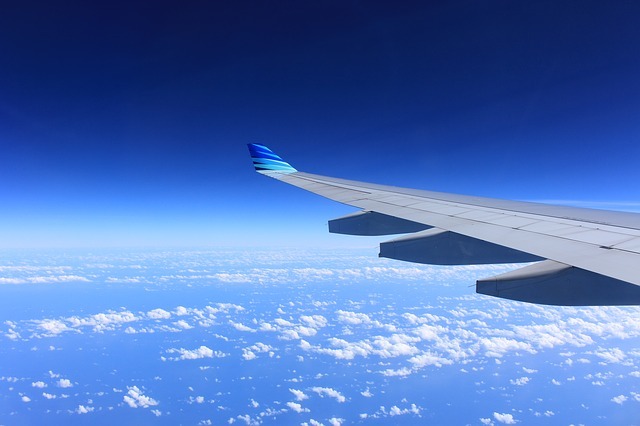
Welcome aboard.
The world of air travel is fascinating. It can also be a bit wacky. From security to airfares to pilot training, through airline customer service issues, we aim to give you a few helpful facts and tips for your next flight with these eye-opening statistics.
“Ladies and gentlemen, the Captain has turned on the Fasten Seat Belt sign. If you haven’t already done so, please stow your carry-on luggage underneath the seat in front of you or in an overhead bin. Please take your seat and fasten your seat belt. And also make sure your seat back and folding trays are in their full upright position.
If you have any questions about our flight today, please don’t hesitate to ask one of our flight attendants.”

Dear passengers, did you know…
• Cabin air is drier than most deserts. At 12 percent humidity, the typical cabin is exceptionally dry and dehydrating due to cruising at high altitudes. Humidifying a cabin is too costly and could cause corrosion, so air travelers are encouraged to stay hydrated and drink water before, during and after a flight.
• Turbulence is a convenience issue, usually not a safety concern. It is an uncomfortable experience, but for lack of a better term, normal. The pilots are not worried about the wings falling off; they are trying to keep customers relaxed and everybody’s drinks where they belong by asking passengers to buckle up. Planes typically only shift 10 to 20 feet during turbulence. They are engineered to handle turbulent conditions.
• The air on airplanes is filtered by the same technology that filters air in hospitals. So while the tray table may harbor germs (and they do, since they are rarely disinfected...), the air is clean. One of the biggest concerns with getting on an aircraft is getting sick because of breathing in dirty, germ-filled air. In fact, there are myths that all the air we breathe in an aircraft is unfiltered and recycled, which would mean that passengers are simply taking in a big whiff of everyone’s germs! But that is not actually the case.
• Every day, there are approximately 200,000 flights around the world.
• Nearly every plane glides during its descent. It is common for planes to descend at what pilots call “flight idle” with the engines still operating and powering, but providing no push. If the engines quit outright, the glide itself would be no different. From 30,000 feet, pilots can plan on a hundred miles' worth of glide.
• On a flight from New York City to San Francisco, the captain earns roughly $6.42 per passenger. The captain of a Boeing 767 earns $180 per flight hour, the plane has 120 seats and the flight lasts six hours. If the average flight is 80 percent full, the captain's earnings is equal to slightly more than $6 of your airfare.
• Passengers and their luggage only account for 10 percent of a plane’s total bulk. Fuel is the biggest factor, sometimes accounting for a third or more of a plane’s total heft. Pilots calculate their kerosene in terms of pounds, not liters. Everything from initial fueling to en-route burn is added or subtracted by weight, not volume.
 • The pilots and copilots on major airlines are not allowed to eat the same food, to avoid the possibility of food poisoning sickening the entire flight crew.
• The pilots and copilots on major airlines are not allowed to eat the same food, to avoid the possibility of food poisoning sickening the entire flight crew.
A few more interesting facts:
• Few rules are more confounding to airline passengers than those regarding the use of cell phones and portable electronic devices. Passengers should know that the restrictions pertaining to computers, iPads, and certain other devices are not about electronic interference. The main reason laptops need to be put away is to prevent them from becoming high-speed projectiles in the event of an impact or sudden deceleration. Cellular communication can ‘potentially’ interfere with cockpit equipment, but in all likelihood, it doesn’t. The machines and electronics in airplanes and cockpits have been designed to shield against any interference. The risks are minimal, or else phones would be collected or inspected visually rather than “relying on the honor system.”
• Food tastes different under pressure, like what we experience in an airplane. For example, our ability to perceive salty tastes is weakened, so tomato juice tastes sweet.
• KLM is the world’s oldest airline, established in 1919. Its first flight between Amsterdam and London took place on May 17th, 1920.
• The lavatories can be unlocked from the outside. There is usually a lock mechanism concealed behind the 'no-smoking' badge on the door. Just lift the flap up and slide the bolt to unlock.
“Cabin crew, please take your seats for landing.”
The best ways to beat jetlag are to reset your internal clock. Here a few tips:
1. Try to shift your sleep pattern: go to bed one hour earlier or later depending on which direction you are flying.
2. If you're going on a really long flight (for instance, from Australia to Europe) take melatonin pills for 2-3 days before the trip.
3. Drink ginger tea.
4. When on the plane, go to sleep as soon as possible, don't take sleeping pills on board, and avoid alcohol, but also coffee.
5. When you arrive, stay up until its bedtime wherever you are. Walk around in the sun, and if you must nap, keep it under an hour.
“For your safety and comfort, please remain seated with your seat belt fastened until the Captain turns off the Fasten Seat Belt sign. This will indicate that we have parked at the gate and that it is safe for you to move about.
Please check around your seat for any personal belongings you may have brought on board with you and please use caution when opening the overhead bins, as heavy articles may have shifted around during the flight.
On behalf of the entire crew, I’d like to thank you for joining us on this trip and we are looking forward to seeing you on board again in the near future.”
As a final note, it is always good to keep in mind:
To most people, the sky is the limit. To those who love aviation, the sky is home. — Anonymous
Sources:
Smith, Patrick, Cockpit Confidential: Everything You Need to Know about Air Travel: Questions, Answers, & Reflections, Sourcebooks, 2013.
http://www.therichest.com/rich-list/most-shocking/10-things-you-didnt-know-about-air-travel/?view=all
http://thechive.com/2014/06/03/pilots-and-flight-attendants-confess-dark-secrets-about-flying-22-photos/
http://www.dailymail.co.uk/sciencetech/article-2419928/Cockpit-Confidential-Pilot-Patrick-Smiths-book-reveals-happens-toilet-flushes-mid-flight.html
http://www.surpriseride.com/blog/extra-fun/24-fun-facts-aviation/
http://facts.randomhistory.com/airplane-facts.html
http://confessionsofatrolleydolly.com/2013/05/31/top-50-useless-aviation-facts/#prettyPhoto
Photo credits:
ETHZ Swissairarchiv (ETHZ Swissairarchiv) , via Wikimedia Commons
Fuzz via Pixabay, CC0 Public Domain License